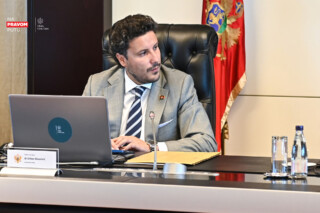Since the political changes in 2020 in Montenegro, when the rule of the Democratic Party of Socialists (DPS) ended after a thirty-year period, the Serbian Orthodox Church (SPC) began to enjoy a very large influence. This is one of the main conclusions of the study called Orthodox Church, Montenegro and Serbian World, published by the NGO Atlantic Initiative.
The authors of the study, Kenneth Morrison and Vesko Garcevic, point out that the Serbian Orthodox Church has an influence on the current government and the majority of political parties present in the political life of Montenegro.
“Its influence can be seen in two directions. One is direct, which is visible, and which has been written about a lot. The second is that it supports a certain kind of ideology and political activism. Parties that want to gain the support of the church simply incorporate that kind of ideology into their political activities. So, we can talk about the appearance of further strengthening of nationalism, as well as the tightening of attitudes towards the LGBTQ population and all minority groups,” Garcevic, professor of international relations at the Frederick S. Pardee School of Global Studies at Boston University, explains for the Voice of America.
It also indicates that the church influences the way history is perceived, as well as the genocide committed in Bosnia and Herzegovina.
“Numerous issues are opened, and such issues are supported by the church. It creates the impression that the parties are not inspired by the church – but the church is inspired by them, to support it. I would say that a symbiosis is created between the two of them,” explains Garcevic, former ambassador of Montenegro to NATO and national coordinator for the Alliance.
According to him, there are constant discussions about the SPC status – because of its unique status and role in the modern history of Montenegro:
“The Serbian Orthodox Church won such a status by creating the Kingdom of Serbs, Croats and Slovenes and changing the status of the former autocephalous Montenegrin Orthodox Church. In the political sense, what brought this issue to the fore is the fact that the status of that church was not defined either in the former Yugoslavia or in the transition period after Yugoslavia. Nor in the interval after the founding of independent Montenegro. It always had the role of some kind of special factor that did not depend on the state of Montenegro. It, on the one hand, was a foreign body, but on the other, it was deeply incorporated into the being of the Montenegrin state, nation and citizens.”
That is a latent conflict between its legal status, as a church that is from Serbia and functions in Montenegro, and the way the authorities perceived it. Sometimes it was tolerated, and sometimes the government was in touch with it. We should not forget that at the end of the 1990s, the Democratic Party of Socialists was very willing to support the Serbian Orthodox Church and Metropolitan Amfilohije. And that he supported Milo Djukanovic when there was a split in DPS. After that, in the 21st century, the Montenegrin state and the Serbian church split. The Montenegrin state was right, from a legal point of view, to point to the undefined status of SPC in Montenegro”, Garcevic stresses, noting that the balance of power has changed again in the last three years in favor of SPC.




